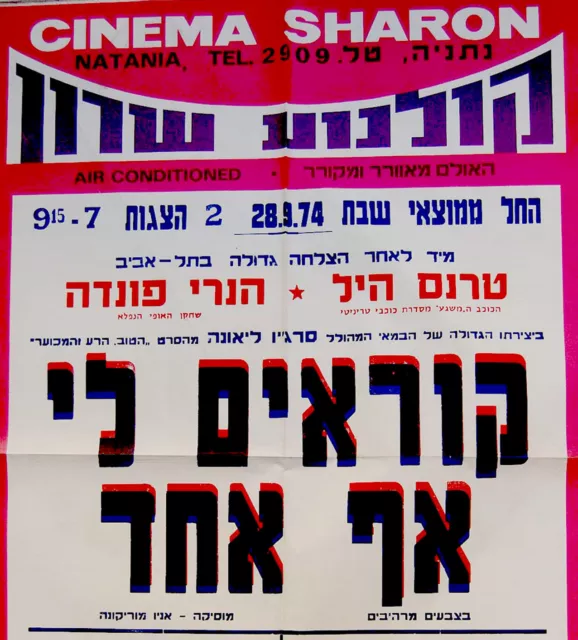1974 Israel FILM POSTER Movie SPAGHETTI WESTERN Hebrew LEONE Terence HILL Fonda
$148.10 Buy It Now or Best Offer, $48.26 Shipping, 30-Day Returns, eBay Money Back Guarantee
Seller: judaica-bookstore ✉️ (2,816) 100%,
Location: TEL AVIV, IL,
Ships to: WORLDWIDE,
Item: 276328224852
1974 Israel FILM POSTER Movie SPAGHETTI WESTERN Hebrew LEONE Terence HILL Fonda.
| DESCRIPTION : Here for sale is an EXCEPTIONALY RARE and ORIGINAL POSTER for the ISRAEL 1974 PREMIERE release of the legendary SPAGHETTI WESTERN COMEDY film " MY NAME IS NOBODY " ( Il mio nome è Nessuno and also GELLERT ) , Directing by SERGIO LEONE , Starring HENRY FONDA and TERENCE HILL , Music by ENNIO MORRICONE in the small rural town of NATHANYA in ISRAEL. The cinema-movie hall " CINEMA SHARON" , An Israeli local version of "Cinema Paradiso" was printing manualy its own posters , And thus you can be certain that this surviving copy is ONE OF ITS KIND. Fully DATED 1974 . Text in HEBREW . Please note : This is NOT a re-release poster but PREMIERE - FIRST RELEASE projection of the film , A year after its release in 1973 in the USA. The Jewish - Judaica ISRAELI distributors of the film have given it a quite archaic and amusing HEBREW text . A bonus to the buyer , A WALT DISNEY film " The ARISTOCATS" in matinee show. GIANT size around 28" x 38" ( Not accurate ) . Printed in red and blue . The condition is very good . 2 folds . Clean ( Pls look at scan for accurate AS IS images ) Poster will be sent rolled in a special protective rigid sealed tube. AUTHENTICITY : The POSTER is fully guaranteed ORIGINAL from 1974 ( dated ) , It is NOT a reproduction or a recently made reprint or an immitation , It holds a with life long GUARANTEE for its AUTHENTICITY and ORIGINALITY. PAYMENTS : Payment method accepted : Paypal & All credit cards . SHIPPMENT : SHIPP worldwide via registered airmail is $ 29 . Poster will be sent rolled in a special protective rigid sealed tube. Handling around 5-10 days after payment. My Name is Nobody (Italian: ''Il mio nome è Nessuno''), also known as Gellert, is a 1973 Spaghetti Western comedy film. The film was directed by Tonino Valerii and, in some scenes, by Sergio Leone.[3] It was written by Leone, Fulvio Morsella and Ernesto Gastaldi. Leone was also the uncredited executive producer. The cast includes Terence Hill, Henry Fonda, and Jean Martin.[4] The title of the movie alludes to the reply Odysseus gave when Polyphemus the Cyclops asked his name. Contents 1 Plot2 Cast3 Production4 Music5 Release and influence6 References7 External links Plot Jack Beauregard (Henry Fonda) is an aging legendary gunslinger who wants to retire in peace in Europe to get away from young gunmen constantly trying to test themselves against the master. The film opens with three gunmen attempting to ambush Beauregard in a barbershop. After Beauregard has dispatched them, the barber's son asks his father if there is anyone in the world faster than Beauregard, to which the barber replies "Faster than him? Nobody!" After getting off a river ferry Beauregard watches a bum (Terence Hill) trying to catch fish. He then carries on to an old goldmine, only to find a dying acquaintance (Red), who has just been shot by a gang. Beauregard asks what happened and about the whereabouts of a certain Nevada, but Red only manages to disclose Nevada's village (Acoma). At a horse relay station the bum is asked by three men to deliver a basket to a certain person inside. It turns out to be Beauregard, who is being informed by the post office boy that his ship to Europe will sail within sixteen days from New Orleans, at a ticket price of $500. The bum impresses Beauregard with his knowledge of the latter's track record, and then throws the basket outside. A bomb inside the basket explodes, leaving the three men in disarray. The bum identifies himself as "Nobody". "Nobody" idolizes Beauregard and wants him to increase his fame by facing off the Wild Bunch single-handed. The Wild Bunch are a gang of 150 bandits who use a fake goldmine to launder their train robbery gold loot. The owner of the goldmine (Sullivan) has a hunch Beauregard is out to kill him, so he tries to get to him first. Hence the two previous attacks on Beauregard. The Wild Bunch however want Sullivan to focus on keeping his reputation clean. At Acoma, Beauregard is awaited by Nobody, who reveals that Nevada is dead by showing him his grave. It turns out that Nevada was Beauregard's brother. Again Nobody challenges him to face the Wild Bunch. Again Beauregard declines, and notices that Nobody's saddle is decorated with mirrored conchas. Nobody arrives at a saloon town. After humiliating the local gunslingers with his drawing speed and accuracy, he is summoned to a private poker room up in the saloon. There he is awaited by Sullivan, who offers him a lavish bounty to kill Beauregard. Nobody agrees, but Sullivan doesn't trust him, and sets up some men of his own around town as a back-up plan. When Beauregard arrives in town, Nobody indeed has no intention of killing him, but on the contrary helps him do away with Sullivan's men. Then, the Wild Bunch rides into town, to collect sticks of dynamite, caching them in their saddles bags, which are decorated with mirrored conchas (much like Nobody's). They ride out again, uninterested in Beauregard and Nobody. An old resident of the town then tells Beauregard that he was bought out of a derelict gold mine by Nevada and Red, only to see them make a deal with Sullivan afterwards. Miraculously, the mine then started producing prodigious amounts of gold. Nobody walks in, again urging Beauregard to face the Wild Bunch, for sport. Beauregard hurries off to the gold mine. At the gold mine, he catches Sullivan loading sacks of gold powder. Sullivan, afraid Beauregard is about to revenge his brother, tells him that it was Red who killed Nevada. He offers Beauregard Nevada's share in the mine. Beauregard tells him he couldn't care less about his despicable brother, and just takes two sacks, and $500 out of Sullivan's wallet. He asks where he can catch a train to New Orleans, and then leaves. A train is being loaded with bars of gold, under the protection of US troops. Nobody tricks the driver and manages to steal the train under their noses. In the mean time, Beauregard has arrived at the train stop, an open spot in the middle of the desert, but the Wild Bunch turn up before the train and he chases away his horse to prepare making a last stand against them. Nobody turns up with the stolen train but refuses to let him on it, insisting he must fight. Beauregard smiles and returns to his shooting station. Then, as Nobody had anticipated, he suddenly remembers the mirroring conchas, and aims at them. One by one they explode, blowing up most of the Wild Bunch. He escapes with Nobody on the train. However, Nobody tells Beauregard that he still has to die. In New Orleans, Beauregard and Nobody finally face each other in a street duel, with lots of spectators and even a photographer. Nobody draws faster and Beauregard falls to the ground, apparently dead. A few days later, Nobody walks by the ship that was to take Beauregard to Europe. A sign with the text "Jack Beauregard, 1848 - 1899. Nobody was faster on the draw." has been erected. However, it is revealed that Beauregard is in his cabin, awaiting departure. He and Nobody staged his death, allowing him to retire peacefully in Europe. Thinking Beauregard is actually dead, the Wild Bunch turn their attention to Nobody, who playfully eludes their attacks. Beauregard writes Nobody a fond farewell letter, reflecting on changing times and the gone romanticism of gunslinging. Cast Terence Hill as NobodyHenry Fonda as Jack BeauregardJean Martin as SullivanR.K. Armstrong as Honest JohnKarl Braun as JimLeo Gordon as RedSteve Kanaly as False BarberGeoffrey Lewis as Leader of the Wild BunchNeil Summers as SquirrelPiero Lulli as SheriffMario Brega as PedroMarc Mazza as Don JohnBenito Stefanelli as PorteleyAntoine Saint-John as Scape Production By the 1970s, the spaghetti Western had almost become a parody of itself. The serious westerns were primarily violent, low-budget films that were barely distributed outside of Italy. Meanwhile, slapstick parodies of the genre were becoming more popular. Sergio Leone and his team decided that if anyone was going to make the ultimate "joke" version of the genre, they should be the ones. Terence Hill was cast for his box-office draw and because he had already starred in the successful spaghetti films They Call Me Trinity and its sequel Trinity Is Still My Name. Inside jokes in the film include invocations of director Sam Peckinpah: his name on a tombstone, the villains being known as "the Wild Bunch", and use of the duster coats which Peckinpah vigorously espoused on screen. R.G. Armstrong (erroneously credited with middle initial "K"), Geoffrey Lewis, and Steve Kanaly also appear in the film, which was shot in New Mexico, New Orleans, and Leone's favorite Spanish locales in Almeria. This is the second time Fonda worked with Leone, the former being Fonda's first turn as a villain, in the classic Once Upon a Time in the West. Noted French actor Jean Martin plays the film's main antagonist. Leone directed several scenes of the film, including the opening scene and the final showdown with the Wild Bunch, but Tonino Valerii was the overall director. After the film's release, it was promoted as a Sergio Leone film, much to the frustration of both men. Music The musical score, by longtime Leone collaborator Ennio Morricone, is a very eclectic one and incorporates a large range of styles. The main theme for the Nobody character presages many of his later non-Western scores. Morricone's adaptation of Wagner's Ride of the Valkyries, which combines with the wailing voices from The Good, the Bad, and the Ugly for the Wild Bunch's theme is typical of the movie's sense of humor. Traces of music from "Once Upon a Time in the West" can also be heard. The main theme was later used for the 2004 BBC3 black comedy Nighty Night. Release and influence It was released under various names in Italy, America, France, and West Germany. The film was Fonda's final western, filmed in Mogollon, Acoma Pueblo and Gallup, New Mexico; Colorado; New Orleans, Louisiana; and Spain. Hill has said it remains his favorite film among those in which he starred, largely because of Sergio Leone's involvement. A loose sequel, titled A Genius, Two Partners and a Dupe (also called Nobody's the Greatest), was released in 1975. References 1. · "Il Mio Nome e Essuno". British Film Institute. Retrieved November 11, 2012. · · Erickson, Hal. "My Name is Nobody". Allmovie. Retrieved November 11, 2012. · · Frayling, Christopher. Sergio Leone: Something to Do With Death , Faber & Faber, 2000. ISBN 0-571-16438-2 · The New York Times Il Mio nome e Nessuno (1974) ' My Name Is Nobody,' Puts Fabled West on Film:The Cast By VINCENT CANBY Published: July 18, 1974 Sergio Leone's "My Name Is Nobody" is the kind of Western that only an immensely appreciative and witty Italian film maker could make. It stars Henry Fonda, one of Hollywood's most noble performers, as the greatest of the old West's gunslingers, and Terence Hill, one of Italy's newest young actors with an anglicized name, as the blond, intensely blue-eyed Nobody who goads, pushes and finally shepherds the older man safely into history. The film, an Italian-French-German co-production that was photographed in New Mexico, Colorado and Spain, opened yesterday at the Loew's State 2, Orpheum and Murray Hill Theaters. Mr. Leone did not actually direct the movie, a job that was handled by Tonino Valerii, a former assistant to Mr. Leone ("A Fistful of Dollars," "Once Upon a Time in the West," etc.), the man who gave the so-called spaghetti Westerns class. Yet it very much looks like a Leone film and, I suspect, it is. It's called "a Sergio Leone presentation," and it's based on his idea. In addition, it's filled with Leone observations about a West he originally encountered in old Hollywood movies. The time is 1899, midnight for the 19th century, when Jack Beauregard (Fonda), the fastest gun still alive, is making his way toward New Orleans and a one-way passage to Europe, where, he assumes, no one will try to pick a fight with him in bars along the Via Veneto. En route to New Orleans, he meets a mysterious young man who says he is Nobody (Hill) whose skills with a gun match his own and who doesn't want to see the great Jack Beauregard fade quietly into anonymity. At times Nobody seems to be a malignant clown who wants nothing more than to ridicule the older man. At still other times he talks half-seriously to Beauregard about ways in which the older man can realize his potential as a legend. Nobody thinks it would be nice if Beauregard single-handedly took on the 150 members of the fabled Wild Bunch (not yet gone to seed as shown in the Sam Peckinpah film), and so arranges this spectacular battle. The plot of "My Name Is Nobody" makes less sense as narrative than as a device on which to hang a series of incidents that are variations on the theme. In this fabled West, life is a continuing series of contests, in bar-rooms, on main streets and on vast plains where two opposing forces miles apart, come together so inevitably and so perfectly it seems they must be equipped with bat-radar. Though it may be too schematic for the taste of many Americans, "My Name Is Nobody" is filled with tumuluous beautifully choreographed action sequences that are so bloodless (a change from the early Leone films) they seem to be slapstick. The style of exaggeration is evident even in the extraordinary clarity of the images and of the sound, so that when we hear the rasping of a straight razor going over a week-old beard, it's as if we were being made aware of each whisker's fate. Mr. Hill is surprisingly effective and sometimes very funny, in a role that is an impossible mixture of Puck, the stage manager in "Our Town," Shane and conventional Ryan O'Neal. Mr. Fonda, as always, is firmly down-to-earth, creating a specific character of the sort that has little truck with the Leonelike introspection. He's a man of action at the end of his career. "My Name Is Nobody" is terribly knowing. It has the manner of a buff who knows absolutely everything about a subject most other people haven't time for, but it's also very entertaining. The Cast MY NAME IS NOBODY, directed by Tonino Valerii; screenplay by Ernesto Gastaldi, based on a story by Fulvio Morsella and Mr. Gastaldi, from an idea by Sergeo Leone; produced by Claudio Mancini; executive producer, Mr. Morsella; directors of photography, Giuseppe Ruzzolini and Armando Mannuzzi; music, Ennio Morricone; editor, Nino Baragli; an Italian-French-German co-production, presented by Mr. Leone; distributed by Universal Pictures. Running time: 115 minutes. At the Loew's State 2, Broadway at 45th Street; Loew's Orpheum, 86th Street near Third Avenue and Murray Hill Theater, 34th Street at Third Avenue. This film has been rated PG. Nobody . . . . . Terence Hill Jack Beauregard . . . . . Henry Fonda Sullivan . . . . . Jean Martin Sheriff . . . . . Piero Lulli Red . . . . . Leo Gordon Honest John . . . . . R. G. Armstrong Westerner . . . . . Neil Summers Sergio Leone (Italian: [ˈsɛrdʒo leˈoːne]; 3 January 1929 – 30 April 1989) was an Italian film director, producer and screenwriter most associated with the "Spaghetti Western" genre.[citation needed] Leone's film-making style includes juxtaposing extreme close-up shots with lengthy long shots. His movies include the sword and sandal action films The Last Days of Pompeii (1959) and The Colossus of Rhodes (1961), the Dollars Trilogy of Westerns featuring Clint Eastwood (A Fistful of Dollars (1964), For a Few Dollars More (1965) and The Good, the Bad and the Ugly (1966)), the Western Once Upon a Time in the West (1968), the epic buddy Zapata Western Duck, You Sucker! (1971) and the epic crime drama Once Upon a Time in America (1984). Contents 1 Early life2 1960s3 1970s4 1980s5 Later years and death6 Unrealized projects 6.1 A Place Only Mary Knows6.2 Leningrad: The 900 Days6.3 Don Quixote6.4 Colt6.5 Other planned films7 Filmography 7.1 Screenplay7.2 Assistant director or second unit director8 Recurring actors9 Awards and nominations10 References11 Further reading12 External links Early life Born in Rome, Leone was the son of the cinema pioneer Vincenzo Leone (known as director Roberto Roberti or Leone Roberto Roberti) and the silent film actress Edvige Valcarenghi (Bice Waleran). During his schooldays, Leone was a classmate of his later musical collaborator Ennio Morricone for a time. After watching his father work on film sets, Leone began his own career in the film industry at the age of 18 after dropping out of law studies at the university. Working in Italian cinematography, he began as an assistant to Vittorio de Sica during the movie The Bicycle Thief in 1948. Leone began writing screenplays during the 1950s, primarily for the 'sword and sandal' (a.k.a. 'peplum') historical epics, popular at the time. He also worked as an assistant director on several large-scale international productions shot at the Cinecittà Studios in Rome, notably Quo Vadis (1951) and Ben-Hur (1959), financially backed by the American studios. When director Mario Bonnard fell ill during the production of the 1959 Italian epic The Last Days of Pompeii (Gli Ultimi Giorni di Pompei), starring Steve Reeves, Leone was asked to step in and complete the film. As a result, when the time came to make his solo directorial debut with The Colossus of Rhodes (Il Colosso di Rodi, 1961), Leone was well equipped to produce low-budget films which looked like larger-budget Hollywood movies. 1960s In the mid-1960s, historical epics fell out of favor with audiences, but Leone had shifted his attention to a subgenre which came to be known as the "Spaghetti Western", owing its origin to the American Western. His film A Fistful of Dollars (Per un Pugno di Dollari, 1964) was based upon Akira Kurosawa's Edo-era samurai adventure Yojimbo (1961). Leone's film elicited a legal challenge from the Japanese director, though Kurosawa's film was in turn probably based on the 1929 Dashiell Hammett novel, Red Harvest. A Fistful of Dollars is also notable for establishing Clint Eastwood as a star. Until that time Eastwood had been an American television actor with few credited film roles. The look of A Fistful of Dollars was established by its Spanish locations, which presented a violent and morally complex vision of the American Old West. The film paid tribute to traditional American western films, but significantly departed from them in storyline, plot, characterization and mood. Leone gains credit for one great breakthrough in the western genre still followed today: in traditional western films, many heroes and villains looked alike as if they had just stepped out of a fashion magazine, with clearly drawn moral opposites, even down to the hero wearing a white hat and the villain wearing a black hat (except for the most successful of the 'traditional western cowboys' - Hopalong Cassidy, who wore a black outfit upon a pale horse). Leone's characters were, in contrast, more 'realistic' and complex: usually 'lone wolves' in their behaviour; they rarely shaved, looked dirty and sweated profusely, and there was a strong suggestion of criminal behaviour. The characters were also morally ambiguous by appearing generously compassionate, or nakedly and brutally self-serving, as the situation demanded. Relationships revolved around power and retributions were emotion-driven rather than conscience-driven. Some critics have noted the irony of an Italian director who could not speak English, and had never even visited the United States, let alone the American Old West, almost single-handedly redefining the typical vision of the American cowboy. According to Christopher Frayling's book Something to do with Death, Leone knew a great deal about the American Old West. It fascinated him as a child, which carried into his adulthood and his films. Clint Eastwood in Leone's For a Few Dollars More, the second part of the Dollars trilogy. Leone's next two films – For a Few Dollars More (1965) and The Good, the Bad and the Ugly (1966) – completed what has come to be known as the Man with No Name trilogy (or the Dollars Trilogy), with each film being more financially successful and more technically accomplished than its predecessor. The films featured innovative music scores by Ennio Morricone, who worked closely with Leone in devising the themes. Leone had a personal way of shooting scenes with Morricone's music ongoing. In addition, Clint Eastwood stayed with the film series, joined later by Eli Wallach, Lee van Cleef and Klaus Kinski. Based on the success of The Man with No Name trilogy, Leone was invited to the United States in 1967 to direct Once Upon a Time in the West (C'Era una Volta il West) for Paramount Pictures. The film was shot mostly in Almería, Spain and Cinecittà in Rome. It was also briefly shot in Monument Valley, Utah. The film starred Charles Bronson, Henry Fonda, Jason Robards and Claudia Cardinale. Once Upon a Time in the West emerged as a long, violent, dreamlike meditation upon the mythology of the American Old West, with many stylistic references to iconic western films. Audience tension is maintained throughout this nearly three-hour film by concealing both the hero's identity and his unpredictable motivation until the final predictable shootout scene. Perhaps unsurpassed as a retribution drama, the film's script was written by Leone and his longtime friend and collaborator Sergio Donati, from a story by Bernardo Bertolucci and Dario Argento, both of whom went on to have significant careers as directors. Before its release, however, it was ruthlessly edited by Paramount, which perhaps contributed to its low box-office results in the United States. Nevertheless, it was a huge hit in Europe, grossing nearly three times its $5 million budget among French audiences, and highly praised amongst North American film students. It has come to be regarded by many as Leone's best film.[1][2] 1970s Leone on the set of A Genius, Two Partners and a Dupe After Once Upon a Time in the West, Leone directed Duck, You Sucker! (Giù la Testa, 1971). Leone was intending merely to produce the film, but due to artistic differences with then-director Peter Bogdanovich, Leone was asked to direct the film instead. Duck, You Sucker! is a Mexican Revolution action drama, starring James Coburn as an Irish revolutionary and Rod Steiger as a Mexican bandit who is conned into becoming a revolutionary. Leone continued to produce, and on occasion, step in to reshoot scenes in other films. One of these films was My Name Is Nobody (1973) by Tonino Valerii (though true participation of Leone in shooting is disputed),[citation needed] a comedy western film that poked fun at the spaghetti western genre. It starred Henry Fonda as an old gunslinger facing a final confrontation after the death of his brother. Terence Hill also starred in the film as the young stranger who helps Fonda leave the dying West with style. Leone's other productions included A Genius, Two Partners and a Dupe (1975, another western comedy starring Terence Hill); The Cat (Il Gatto; 1977, starring Ugo Tognazzi), and A Dangerous Toy (Il Giocattolo; 1979, starring Nino Manfredi). Leone also produced three comedies by actor/director Carlo Verdone, which were Fun Is Beautiful (Un Sacco Bello, 1980), Bianco, Rosso e Verdone (White, Red and Verdone – Verdone means "strong green" – a pun referring to the three colours of the Italian flag, the star and to director Verdone, 1981) and Troppo Forte (Great!, 1986). During this period, Leone also directed various award-winning TV commercials for European television. In 1978, he was a member of the jury at the 28th Berlin International Film Festival.[3] 1980s Sergio Leone on the set of Once Upon a Time in America Leone turned down the opportunity to direct The Godfather, in favor of working on another gangster story he had conceived earlier. He devoted ten years to this project, based on the novel The Hoods by former mobster Harry Grey, which focused on a quartet of New York City Jewish gangsters of the 1920s and 1930s who had been friends since childhood. The four-hour finished film, Once Upon a Time in America (1984), featured Robert De Niro and James Woods. It was a meditation on another aspect of popular American mythology, the role of greed and violence and their uneasy coexistence with the meaning of ethnicity and friendship. Feeling the final cut was too long, Warner Bros. recut it drastically for the American market, abandoning its flashback structure for a linear narrative. Lasting just over two hours, the recut version shown in North America received much criticism and flopped. The original version, released in the rest of the world, achieved somewhat better box office returns and a mixed critical response. When the original version of the film was released on home video in the US, it finally gained major critical acclaim, with some critics hailing the film as a masterpiece. According to biographer Sir Christopher Frayling, Leone was deeply hurt by the studio-imposed editing and poor commercial reception of Once Upon a Time in America in North America. It would be his last film. In 1988, he was head of the jury at the 45th Venice International Film Festival.[4] Later years and death Leone died on 30 April 1989, of a heart attack at the age of 60. Before his death he was part way through planning a film on the Siege of Leningrad, set in the Eastern Front during World War II. He was survived by his wife and three children. In his later years, Leone had a falling out of sorts with actor Clint Eastwood. When Leone directed Once Upon a Time in America, he commented that Robert De Niro was a real actor, unlike Eastwood. This may have been in response to Eastwood declining to play the Irish police detective in the aforementioned film, according to one biography. However, the two made amends and reconciled before Leone's death. In 1992, Eastwood directed Unforgiven, a revisionist western drama for which he won an Oscar for best director, as well as Best Picture. Leone was one of the two directors whom Eastwood dedicated his award to (the other was Don Siegel) and the film contains the dedication "To Sergio & Don" before the end credits roll. Unrealized projects A Place Only Mary Knows A treatment for an "Americanized" western was written by Leone, Luca Morsella, and Fabio Toncelli. It is speculated to have been Leone's last western and was to have starred Mickey Rourke and Richard Gere as the two main leads. Set during the height of the American Civil War, the story focused on a Union drafter, Mike Kutcher from Georgia, whose job is to enroll men into the Union army. The other is Richard Burns, a Southern shady businessman transplanted to the North after a successful heist with his ex-lover and partner, Mary. Searching for the buried treasure left behind in an unmarked grave outside Atlanta in “A Place Only Mary Knows”. Joined by a freed slave and an Italian immigrant, Francesco, who arrives via the port of Boston, they try desperately to avoid the battles of the ongoing war between the states. The film was to have been a homage to classic writers from literature such as — Edgar Lee Masters (Spoon River Anthology), Ambrose Bierce (An Occurrence at Owl Creek Bridge), Mark Twain (A Military Campaign that Failed), Stephen Crane (The Red Badge of Courage), and Margaret Mitchell (Gone with the Wind), of whose novel he had wanted to film a remake. Although the written treatment never got turned into a full screenplay, Leone's son Andrea had it published in a June 2004 issue of the Italian cinema magazine Ciak. It is unsure if the treatment's publication will ever lead to a full production in America or Italy. Leningrad: The 900 Days While finishing work on Once Upon a Time in America in 1982, Leone was impressed with Harrison Salisbury's non-fiction book The 900 Days: The Siege of Leningrad, and he planned on adapting the book as a war epic. Although no formal script had been completed or leaked, Leone came up with the opening scene and basic plot. According to the documentary Once Upon a Time, Sergio Leone, the film opened in medias res as the camera goes from focusing on a Russian hiding from the Nazis' artillery fire to panning hundreds of feet away to show the German Panzer divisions approaching the walls of the city. The plot was to focus on an American photographer on assignment (whom Leone wanted to be played by Robert De Niro) becoming trapped in Russia as the German Luftwaffe begin to bombard the city. Throughout the course of the film, he becomes romantically involved with a Russian woman, whom he later impregnates, as they attempt to survive the prolonged siege and the secret police, because relationships with foreigners are forbidden. According to Leone, "In the end, the cameraman dies on the day of the liberation of the city, when he is currently filming the surrender of the Germans. And the girl is aware of his death by chance seeing a movie news: the camera sees it explode under a shell .... "[5] By 1989, Leone had been able to acquire $100 million in financing from independent backers, and the film was to be a joint production with a Soviet film company. He had convinced Ennio Morricone to compose the film score, and Tonino Delli Colli was tapped to be the cinematographer. Shooting was scheduled to begin sometime in 1990. The project was canceled when Leone died two days before he was to officially sign on for the film. Don Quixote According to Frayling's biography of Leone, Something to Do with Death, he envisioned a contemporary adaptation of Cervantes' 17th century novel Don Quixote with Clint Eastwood in the title role and Eli Wallach as Sancho Panza.[6] He had discussed doing the project throughout the 1960s-1970s, and he started seriously considering it towards the end of his life. Colt In 1987, Sergio Leone contacted his old collaborators Sergio Donati and Fulvio Morsella, pitching an idea for a TV miniseries about a Colt revolver that passed from owner to owner throughout the Old West, similar to Anthony Mann's film Winchester '73 (1950). Donati indicated that Leone was interested in a more revisionist take on the genre than his earlier works, wanting to show the Old West "like it really was." Leone abandoned this project in favor of A Place Only Mary Knows, though Donati wrote a treatment and the project remained in gestation for years after Leone's death.[7] Other planned films Leone was also an avid fan of Margaret Mitchell's novel Gone with the Wind and the 1939 film adaptation. His relatives and close friends stated that he talked about filming a remake that was closer to the original novel, but it never advanced beyond discussions to any serious form of production. Leone was a fan of Louis-Ferdinand Céline's novel Journey to the End of the Night and was considering a film adaptation in the late 1960s; he incorporated elements of the story into The Good, the Bad and the Ugly and Duck, You Sucker! but his idea of adapting the novel itself never got past the planning stages. Leone also started writing a screenplay based on Lee Falk's The Phantom, and scouted locations for the project. Despite this, he never got to make a movie based on the comic book hero. He declared he would have liked to follow his Phantom project with a movie based on another Falk-created character, Mandrake the Magician.[8] Leone was an early choice to direct Flash Gordon (1980). Leone was a fan of the original Alex Raymond comic strip, but turned down the film because the script did not resemble Raymond's work.[9] Filmography Year English title Italian title Notes 1959 The Last Days of Pompeii Gli Ultimi Giorni di Pompei Mario Bonnard is the credited director; Leone served as assistant director and reportedly took over completion of the film when Bonnard became severely ill during production. 1961 The Colossus of Rhodes Il Colosso di Rodi His debut film 1964 A Fistful of Dollars Per un Pugno di Dollari First part of the Dollars Trilogy 1965 For a Few Dollars More Per Qualche Dollaro in Più Second part of the Dollars Trilogy 1966 The Good, the Bad and the Ugly Il Buono, il Brutto, il Cattivo Third part of the Dollars Trilogy 1968 Once Upon a Time in the West C'era una volta il West 1971 Duck, You Sucker! (aka A Fistful of Dynamite or Once Upon a Time... the Revolution) Giù la Testa His last credited western film 1973 My Name Is Nobody Il Mio Nome è Nessuno Producer, uncredited co-director 1975 A Genius, Two Partners and a Dupe Un Genio, Due Compari, un Pollo Uncredited producer, co-director; his last western film 1984 Once Upon a Time in America C'era una Volta in America His last film Screenplay 1958: Afrodite, dea dell'amore1959: The Last Days of Pompeii1959: Nel Segno di Roma1961: The Seven Revenges1961: Romolo e Remo1961: Il Colosso di Rodi1964: A Fistful of Dollars1964: Slave Girls of Sheba1965: For a Few Dollars More1966: The Good, the Bad and the Ugly1968: Once Upon a Time in the West1971: Duck, You Sucker!1975: A Genius, Two Partners and a Dupe1984: Once Upon a Time in America1986: Troppo forte Assistant director or second unit director 1946: Rigoletto1948: Bicycle Thieves1948: La Legenda di Faust1949: Fabiola1949: Ill Trovatore1950: Taxi di Notte1950: Il Voto1950: Il Brigante Musolino1951: Quo Vadis1952: I tre corsari1952: Jolanda, la figlia del Corsaro Nero1952: Ill folle di Maracharo1953: Man, Beast and Virtue1953: La tratta delle bianche1953: Frine, cortigiana d'Oriente1954: Tradita1954: Of Life and Love1955: La Ladra1956: Mi permette Babbo !1957: Il Maestro1958: Afrodite, dea dell'amore1959: La legge mi incolpa1959: Il figlio del corsaro rosso1959: Ben-Hur1962: Sodom and Gomorrah Terence Hill (born Mario Girotti; 29 March 1939) is an Italian actor.[1] Hill is of Italian and German descent who began as a child actor and went on to multiple starring roles in action and other Italian films, many with longtime film partner and friend Bud Spencer. During the height of his popularity Hill was among Italy's highest paid actors,[2] Hill's most widely seen films include comic and standard Westerns all´Italiana ("Italian style Westerns," colloquially, "spaghetti westerns"), some based on popular novels by German author Karl May about the American West. Of these, the most famous are Lo chiamavano Trinità (They Call Me Trinity, 1971) and Il mio nome è Nessuno (My Name Is Nobody, 1973), co-starring Henry Fonda. His film Django, Prepare a Coffin, shot in 1968 by director Ferdinando Baldi, and co-starring Horst Frank and George Eastman, was featured at the 64a La Biennale di Venezia (64th Venice Film Festival) in 2007. Hill, whose stage name was the product of a publicity stunt by film producers, also went on to a successful television career in Italy, including the long running lead and title role of Don Matteo (2000-), about an inspirational parish priest who assists the Carabinieri in solving crimes local to his community, a role for which Hill received an international "Outstanding Actor of the Year" award at the Festival de Télévision de Monte-Carlo 42e (42nd Monte Carlo Television Festival). Contents 1 Early life and career2 Career as an adult3 Personal life4 Filmography5 References6 External links Early life and career This section of a biographical article needs additional citations for verification. Please help by adding reliable sources. Contentious material about living persons that is unsourced or poorly sourced must be removed immediately, especially if potentially libelous or harmful. (May 2015) Hill was born on March 29, 1939 in Venice, Italy.[2] Hill's mother, Hildegard Girotti (née Thieme), was a German, from Dresden; his father, Girolamo Girotti, was Italian, and a chemist by occupation.[3][full citation needed] Hill lived in the small town of Lommatzsch, Germany during his childhood years, including during the end of the second world war, 1943-1945 , and survived the Dresden Bombing.[citation needed] He was discovered by Italian filmmaker Dino Risi at a swimming meet at the age of 12, and became a child actor, appearing in Vacanze col Gangster (Holiday with the Gangster, 1951).[2] His early roles also included Gli sbandati (The Abandoned, 1955). Career as an adult This section of a biographical article needs additional citations for verification. Please help by adding reliable sources. Contentious material about living persons that is unsourced or poorly sourced must be removed immediately, especially if potentially libelous or harmful. (May 2015) At one time among Italy's highest paid actors,[when?][2] Hill's most widely seen films include comic and standard Westerns all´ Italiana ("Italian style Westerns,"[4] also known as "Spaghetti Westerns"), some based on popular novels by German author Karl May about the American West. After 27 movies in Italy Hill secured a major film role in Luchino Visconti's The Leopard (Il Gattopardo, 1963).[citation needed] In 1964, he returned to Germany and there appeared in a series of Heimatfilmen, adventure and western films, made after novels by German author Karl May.[citation needed] In 1967, he returned to Italy to act in God Forgives... I Don't! (Dio perdona... Io no!, 1968). His film "Django, Prepare the coffin" was also shot in 1968, by director Ferdinando Baldi; it co-starred Horst Frank and George Eastman (and would be featured, much later, at the 64a La Biennale di Venezia (64th Venice Film Festival, in 2007).[4] Hill changed his name from Mario Girotti to Terence Hill the same year, a name made up as a publicity stunt by the film producers; he had to choose from a list of twenty names and picked the one with his mother's initials.[citation needed] In a question and answer session, he dismissed as a journalist's invention the rumor that it might have been taken from the Roman playwright Terence and his wife's surname.[5][self-published source?] (His wife's maiden name was Zwicklbauer.[citation needed]) In the following years, he starred in many action and Spaghetti Westerns, together with longtime colleague and friend Bud Spencer.[citation needed] The pair made a large number of Italian Westerns and other films together, and were notable for their comedy films, successful not only in Italy, but also abroad.[citation needed] Many of these have alternate titles, depending upon the country and distributor. Possibly their most famous film is the 1971 western Lo chiamavano Trinità (They Call Me Trinity) and the 1972 sequel Continuavano a chiamarlo Trinità (Trinity Is STILL My Name!).[citation needed] Hill has stated in interviews that Il mio nome è Nessuno (My Name Is Nobody, 1973), in which he co-starred with Henry Fonda,[6] is his personal favorite of all his films.[citation needed] His first American films were Mr. Billion and March or Die (both 1977), after which he divided his time between Italy and the US.[citation needed] Hill later went on to a successful television career in Italy; in 2000, he landed the leading role in the Italian television series Don Matteo, about an inspirational parish priest who assists the Carabinieri in solving crimes local to his community.[citation needed] This role earned Hill an international "Outstanding Actor of the Year" award at the Festival de Télévision de Monte-Carlo 42e (42nd Monte Carlo Television Festival), alongside ones for the series, and for producer Alessandro Jacchia at that festival.[7][better source needed] In the summer of 2010 Hill filmed another successful Italian television series for the Italian state TV channel Rai Uno, this time entitled Un passo dal cielo (One step from heaven), playing a local chief of the foresters in the region of Alto Adige, the Italian Tyrol, with a second similarly successful season filmed in 2012.[citation needed] Personal life Hill was married to Lori Hill née Zwicklbauer.[citation needed] Hill had an adoptive son, Ross, who was killed in an accident in Stockbridge, Massachusetts in 1990 while the actor was preparing to film Lucky Luke on the Bonanza Creek Ranch near Santa Fe.[citation needed] Filmography Vacanze col gangster (Vacation with a Gangster, 1951)Un Amore per te (1952)La voce del silenzio (Voice of Silence, 1953)Villa Borghese (It Happened in the Park, 1953)Divisione Folgore (Folgore Division, 1954)Gli sbandati (Abandoned, 1955)La vena d'oro (1955)I vagabondi delle stelle (1956)Mamma sconosciuta (1956)Lazzarella (1957)Guaglione (1957)La grande strada azzurra (The Wide Blue Road, 1957)La spada e la croce (The Sword and the Cross, 1958)Il Novelliere: The picture of Dorian Gray (1958, TV)Anna di Brooklyn (Anna of Brooklyn, 1958)Cerasella (1959)Spavaldi e innamorati (1959)Il padrone delle ferriere (1959)Primo Amore (1959)Giuseppe venduto dai fratelli (The Story of Joseph and His Brethren, 1960)Un militare e mezzo (1960)Cartagine in fiamme (Carthage in Flames, 1960)Annibale (Hannibal, 1960)Juke box urli d'amore (1960)Pecado de amorLe meraviglie di Aladino (The Wonders of Aladdin, 1961)Il Giorno più corto (The Shortest Day, 1962)Il Dominatore dei sette mari (Seven Seas to Calais, 1962)Il Gattopardo (The Leopard, 1963)Winnetou - 2. Teil (Last of the Renegades, 1964)Unter Geiern (Among Vultures, 1964)Duell vor Sonnenuntergang (Duel at Sundown, 1965)Schüsse im Dreivierteltakt (Shots in Threequarter Time, 1965)Der Ölprinz (1965)Ruf der Wälder (1965)Old Surehand (Flaming Frontier, 1965)Die Nibelungen, Teil 1: Siegfried (1966)Little Rita nel West (Rita of the West, 1967)La Feldmarescialla (The Crazy Kids of the War, 1967)Io non protesto, io amo (1967)Die Nibelungen, Teil 2: Kriemhilds Rache (1967)Dio perdona... Io no! (God Forgives... I Don't!, 1967)Preparati la bara! (Django, Prepare the Coffin, 1968)I quattro dell'Ave Maria (Ace High, 1968)Barbagia (The Tough and the Mighty, 1969)La collina degli stivali (Boot Hill, 1969)The Wind's Fierce (1970)Lo chiamavano Trinità (They Call Me Trinity, 1970)Il corsaro nero (Blackie the Pirate, 1971)...continuavano a chiamarlo Trinità (Trinity Is Still My Name, 1971)Più forte, ragazzi! (All the Way, Boys, 1972)Il vero e il falso (The Hassled Hooker, 1972)E poi lo chiamarono il magnifico (Man of the East, 1972)Il mio nome è Nessuno (My Name Is Nobody, 1973)Porgi l'altra guancia (Two Missionaries, 1974)...altrimenti ci arrabbiamo (Watch Out, We're Mad!, 1974)Un genio, due compari, un pollo (A Genius, Two Partners and a Dupe, 1975)I due superpiedi quasi piatti (Crime Busters, 1977)Mr. Billion (1977)March or Die (1977)Pari e dispari (Odds and Evens, 1978)Io sto con gli ippopotami (I'm with the Hippos, 1979)Poliziotto superpiù (Super Fuzz, 1980)Chi trova un amico, trova un tesoro (A Friend Is a Treasure, 1981)Nati con la camicia (Go for It, 1983)Don Camillo (The World of Don Camillo, 1983)Non c'è due senza quattro (Double Trouble, 1984)Miami Supercops - I poliziotti dell'ottava strada (Miami Supercops, 1985)Renegade - Un osso troppo duro (They Call Me Renegade, 1987)Lucky Luke (1991)Lucky Luke (8 episodes, 1992)Botte di Natale (Troublemakers, 1994)Virtual Weapon (Cyberflick, 1997)Don Matteo (10 seasons/194 episodes, 2000–2014)L'uomo che sognava con le aquile (2006, TV)L'uomo che cavalcava nel buio (2009)Doc West (2009)Un passo dal cielo (46 episodes, 2010–2015) Henry Jaynes "Hank" Fonda (May 16, 1905 – August 12, 1982) was an American film and stage actor[2] with a career spanning more than five decades. Fonda made his mark early as a Broadway actor. He also appeared in 1938 in plays performed in White Plains, New York, with Joan Tompkins.[3] He made his Hollywood debut in 1935, and his career gained momentum after his Academy Award-nominated performance as Tom Joad in The Grapes of Wrath, a 1940 adaptation of John Steinbeck's novel about an Oklahoma family who moved west during the Dust Bowl. Throughout six decades in Hollywood, Fonda cultivated a strong, appealing screen image in such classics as The Ox-Bow Incident, Mister Roberts and 12 Angry Men. Later, Fonda moved both toward darker epics such as Sergio Leone's Once Upon a Time in the West and lighter roles in family comedies such as Yours, Mine and Ours with Lucille Ball, winning the Academy Award for Best Actor at the 54th Academy Awards for the movie On Golden Pond, his final film role. Fonda was the patriarch of a family of famous actors, including daughter Jane Fonda, son Peter Fonda, granddaughter Bridget Fonda, and grandson Troy Garity. His family and close friends called him "Hank". In 1999, he was named the sixth-Greatest Male Star of All Time by the American Film Institute. Contents 1 Family history and early life2 Career 2.1 Early stage work2.2 Entering Hollywood2.3 Postwar career2.4 Late career3 Personal life 3.1 Marriages and children3.2 Politics3.3 On acting4 Death and legacy5 Filmography6 Broadway stage performances7 Awards8 See also9 References10 Bibliography11 External links Family history and early life The Fonda surname originated with immigrants from Genoa, Italy, to the Netherlands, in the 15th century. In 1642, a branch of the Fonda family immigrated to the Dutch colony of New Netherland, on the East Coast of North America.[4] They were among the first Dutch population to settle in what is now upstate New York, establishing the town of Fonda, New York. By 1888, many of their descendants had relocated to Nebraska.[5] Henry Fonda was born in Grand Island, Nebraska,[6] to advertising-printing jobber William Brace Fonda, and his wife, Elma Herberta (née Jaynes), in the second year of their marriage.[7] Fonda was brought up as a Christian Scientist, though he was baptized an Episcopalian at St. Stephen's Episcopal Church[citation needed] in Grand Island. He said, "My whole damn family was nice." They were a close family and highly supportive, especially in health matters, as they avoided doctors due to their religion.[8] Despite having a religious background, he later became an agnostic.[9] Fonda was a bashful, short boy who tended to avoid girls, except his sisters, and was a good skater, swimmer, and runner. He worked part-time in his father's print plant and imagined a possible career as a journalist. Later, he worked after school for the phone company. He also enjoyed drawing. Fonda was active in the Boy Scouts of America; Teichmann reports that he reached the rank of Eagle Scout.[10] When he was about 14, his father took him to observe the lynching, of a young black man accused of rape.[11] This enraged the young Fonda and he kept a keen awareness of prejudice for the rest of his life.[12] By his senior year in high school, Fonda had grown to more than six feet tall, but remained shy. He attended the University of Minnesota, where he majored in journalism,[13] but he did not graduate. He took a job with the Retail Credit Company. Career Early stage work At age 20, Fonda started his acting career at the Omaha Community Playhouse, when his mother's friend Dodie Brando (mother of Marlon Brando) recommended that he try out for a juvenile part in You and I, in which he was cast as Ricky.[6] He was fascinated by the stage, learning everything from set construction to stage production, and embarrassed by his acting ability.[14] When he received the lead in Merton of the Movies, he realized the beauty of acting as a profession, as it allowed him to deflect attention from his own tongue-tied personality and create stage characters relying on someone else's scripted words. Fonda decided to quit his job and go East in 1928 to seek his fortune. He arrived on Cape Cod and played a minor role at the Cape Playhouse in Dennis, Massachusetts. A friend took him to Falmouth, MA where he joined and quickly became a valued member of the University Players, an intercollegiate summer stock company. There he worked with Margaret Sullavan, his future wife.[15] James Stewart joined the Players a few months after Fonda left, though they were soon to become lifelong friends. Fonda left the Players at the end of their 1931-1932 season after appearing in his first professional role in The Jest, by Sem Benelli. Joshua Logan, a young sophomore at Princeton who had been double-cast in the show, gave Fonda the part of Tornaquinci, "an elderly Italian man with a long white beard and even longer hair." Also in the cast of The Jest with Fonda and Logan were Bretaigne Windust, Kent Smith, and Eleanor Phelps.[16] The tall (6 ft, 1.5 in) and slim (160 lb) Fonda headed for New York City, to be with his now wife, Margaret Sullavan. The marriage was brief, but when James Stewart came to New York his luck changed. Getting contact information from Joshua Logan, Jimmy, as he was called, found Hank Fonda and these small town boys found they had a lot in common, as long as they didn't discuss politics. The two men became roommates and honed their skills on Broadway. Fonda appeared in theatrical productions from 1926 to 1934. They fared no better than many Americans in and out of work during the Great Depression, sometimes lacking enough money to take the subway.[17] Entering Hollywood Fonda in Jezebel Fonda got his first break in films when he was hired in 1935 as Janet Gaynor's leading man in 20th Century Fox's screen adaptation of The Farmer Takes a Wife; he reprised his role from the Broadway production of the same name, which had gained him critical recognition. Suddenly, Fonda was making $3,000 a week and dining with Hollywood stars such as Carole Lombard.[18] Stewart soon followed him to Hollywood, and they roomed together again, in lodgings next door to Greta Garbo. In 1935, Fonda starred in the RKO film I Dream Too Much with the opera star Lily Pons. The New York Times announced him as "Henry Fonda, the most likable of the new crop of romantic juveniles."[19] Fonda's film career blossomed as he costarred with Sylvia Sidney and Fred MacMurray in The Trail of the Lonesome Pine (1936), the first Technicolor movie filmed outdoors. He starred with ex-wife Margaret Sullavan in The Moon's Our Home, and a short rekindling of their relationship led to a brief but temporary consideration of remarriage. Fonda got the nod for the lead role in You Only Live Once (1937), also costarring Sidney, and directed by Fritz Lang. He was a critical success opposite Bette Davis, who had picked him, in the film Jezebel (1938). This was followed by the title role in Young Mr. Lincoln (1939), his first collaboration with director John Ford, and that year he played Frank James in Jesse James (1939). Another 1939 film was Drums Along the Mohawk, also directed by Ford. Fonda in The Lady Eve Fonda's successes led Ford to recruit him to play Tom Joad in the film version of John Steinbeck's novel The Grapes of Wrath (1940). A reluctant Darryl Zanuck, who preferred Tyrone Power, insisted on Fonda's signing a seven-year contract with his studio, Twentieth Century-Fox.[20] Fonda agreed, and was ultimately nominated for an Academy Award for his work in the 1940 film, which many consider to be his finest role. Fonda starred in The Return of Frank James (1940) with Gene Tierney. He then played opposite Barbara Stanwyck in Preston Sturges' The Lady Eve (1941), and again teamed with Tierney in the successful screwball comedy Rings on Her Fingers (1942). She was one of Fonda's favorite co-stars, and they appeared in three films together. He was acclaimed for his role in The Ox-Bow Incident (1943). Fonda after enlisting in the United States Navy in November 1942 Fonda enlisted in the United States Navy to fight in World War II, saying, "I don't want to be in a fake war in a studio."[21] Previously, Stewart and he had helped raise funds for the defense of Britain.[22] Fonda served for three years, initially as a Quartermaster 3rd Class on the destroyer USS Satterlee. He was later commissioned as a Lieutenant Junior Grade in Air Combat Intelligence in the Central Pacific and was awarded the Navy Presidential Unit Citation and the Bronze Star.[23] Postwar career After the war, Fonda took a break from movies and attended Hollywood parties and enjoyed civilian life. Stewart and Fonda would listen to records and invite Johnny Mercer, Hoagy Carmichael, Dinah Shore, and Nat King Cole over for music, with the latter giving the family piano lessons.[24] Fonda played Wyatt Earp in My Darling Clementine (1946), which was directed by John Ford. Fonda did seven postwar films until his contract with Fox expired, the last being Otto Preminger's Daisy Kenyon (1947), opposite Joan Crawford. He starred in The Fugitive (1947), which was the first film of Ford's new production company, Argosy Pictures. In 1948, he appeared in a subsequent Argosy/Ford production, Fort Apache, as a rigid Army colonel, along with John Wayne and Shirley Temple in her first adult role. Fonda in Navy uniform Refusing another long-term studio contract, Fonda returned to Broadway, wearing his own officer's cap to originate the title role in Mister Roberts, a comedy about the Navy, where Fonda, a junior officer, wages a private war against the captain. He won a 1948 Tony Award for the part. Fonda followed that by reprising his performance in the national tour and with successful stage runs in Point of No Return and The Caine Mutiny Court-Martial. After an eight-year absence from films, he starred in the 1955 film version of Mister Roberts with James Cagney, William Powell, and Jack Lemmon, continuing a pattern of bringing his acclaimed stage roles to life on the big screen. On the set of Mister Roberts, Fonda came to blows with John Ford, who punched him during filming, and Fonda vowed never to work for the director again. While he kept that vow for years, Fonda spoke glowingly of Ford in Peter Bogdanovich's documentary Directed by John Ford and in a documentary on Ford's career alongside Ford and James Stewart. Fonda refused to participate until he learned that Ford had insisted on casting Fonda as the lead in the film version of Mr. Roberts, reviving Fonda's film career after concentrating on the stage for years. After Mr. Roberts, Fonda next acted in Paramount Pictures's production of the Leo Tolstoy epic War and Peace (1956), in which he played Pierre Bezukhov opposite Audrey Hepburn; it took two years to shoot. Fonda worked with Alfred Hitchcock in 1956, playing a man falsely accused of robbery in The Wrong Man; the unusual semidocumentary work of Hitchcock's was based on an actual incident and partly filmed on location. Lauren Bacall, Humphrey Bogart, and Fonda in a live 1955 TV version of The Petrified Forest In 1957, Fonda made his first foray into production with 12 Angry Men, based on a teleplay and a script by Reginald Rose and directed by Sidney Lumet. The low-budget movie was completed in 17 days of filming, mostly in one claustrophobic jury room. It had a strong cast, including Jack Klugman, Lee J. Cobb, Martin Balsam, and E. G. Marshall. The intense film about 12 jurors deciding the fate of a young Puerto Rican man accused of murder was well received by critics worldwide. Fonda shared the Academy Award and Golden Globe nominations with co-producer Reginald Rose and won the 1958 BAFTA Award for Best Actor for his performance as "Juror #8", who with logic and persistence eventually sways all the jurors to an acquittal. Early on, the film drew poorly, but after winning critical acclaim and awards, it proved a success. In spite of the good outcome, Fonda vowed that he would never produce a movie again, fearing that failing as a producer might derail his acting career.[25] After acting in the western movies The Tin Star (1957) and Warlock (1959), Fonda returned to the production seat for the NBC western television series The Deputy (1959–1961), in which he starred as Marshal Simon Fry. His co-stars were Allen Case and Read Morgan. Fonda in How the West Was Won During the 1960s, Fonda performed in a number of war and western epics, including 1962's The Longest Day and the Cinerama production How the West Was Won, 1965's In Harm's Way, and Battle of the Bulge. In the Cold War suspense film Fail-Safe (1964), Fonda played the President of the United States who tries to avert a nuclear holocaust through tense negotiations with the Soviets after American bombers are mistakenly ordered to attack the USSR. He also returned to more light-hearted cinema in Spencer's Mountain (1963), which was the inspiration for the TV series, The Waltons. Fonda appeared against type as the villain 'Frank' in 1968's Once Upon a Time in the West. After initially turning down the role, he was convinced to accept it by actor Eli Wallach and director Sergio Leone, who flew from Italy to the United States to persuade him to take the part. Fonda had planned on wearing a pair of brown-colored contact lenses, but Leone preferred the paradox of contrasting close-up shots of Fonda's innocent-looking blue eyes with the vicious personality of the character Fonda played. Fonda's relationship with Jimmy Stewart survived their disagreements over politics — Fonda was a liberal Democrat, and Stewart a conservative Republican. After a heated argument, they avoided talking politics with each other. The two men teamed up for 1968's Firecreek, where Fonda again played the heavy. In 1970, Fonda and Stewart co-starred in the western The Cheyenne Social Club, a minor film in which they humorously argued politics. They had first appeared together on film in On Our Merry Way (1948), a comedy which also starred William Demarest and Fred MacMurray and featured a grown-up Carl "Alfalfa" Switzer, who had acted as a child in Our Gang.[26] Late career Despite approaching his seventies, Fonda continued to work in theater, television and film through the 1970s. In 1970, Fonda appeared in three films; the most successful was The Cheyenne Social Club. The other two films were Too Late the Hero, in which Fonda played a secondary role, and There Was a Crooked Man, about Paris Pitman Jr. (played by Kirk Douglas) trying to escape from an Arizona prison. Fonda returned to both foreign and television productions, which provided career sustenance through a decade in which many aging screen actors suffered waning careers. He starred in the ABC television series The Smith Family between 1971 and 1972. A TV-movie adaptation of John Steinbeck's novel, 1973's The Red Pony, earned Fonda an Emmy nomination. After the unsuccessful Hollywood melodrama, Ash Wednesday, he filmed three Italian productions released in 1973 and 1974. The most successful of these, My Name is Nobody, presented Fonda in a rare comedic performance as an old gunslinger whose plans to retire are dampened by a "fan" of sorts. Fonda continued stage acting throughout his last years, including several demanding roles in Broadway plays. He returned to Broadway in 1974 for the biographical drama, Clarence Darrow, for which he was nominated for a Tony Award. Fonda's health had been deteriorating for years, but his first outward symptoms occurred after a performance of the play in April 1974, when he collapsed from exhaustion. After the appearance of a cardiac arrhythmia brought on by prostate cancer, he had a pacemaker installed following cancer surgery. Fonda returned to the play in 1975. After the run of a 1978 play, First Monday of October, he took the advice of his doctors and quit plays, though he continued to star in films and television. Fonda appeared in a revival of The Time of Your Life that opened in March 17, 1972, at the Huntington Hartford Theater in Los Angeles, where Fonda, Richard Dreyfuss, Gloria Grahame, Ron Thompson,[27] Strother Martin, Jane Alexander, Lewis J. Stadlen, Richard X. Slattery, and Pepper Martin were among the cast with Edwin Sherin directing.[28][29] In 1976, Fonda appeared in several notable television productions, the first being Collision Course, the story of the volatile relationship between President Harry Truman (E. G. Marshall) and General MacArthur (Fonda), produced by ABC. After an appearance in the acclaimed Showtime broadcast of Almos' a Man, based on a story by Richard Wright, he starred in the epic NBC miniseries Captains and Kings, based on Taylor Caldwell's novel. Three years later, he appeared in ABC's Roots: The Next Generations, but the miniseries was overshadowed by its predecessor, Roots. Also in 1976, Fonda starred in the World War II blockbuster Midway. Fonda finished the 1970s in a number of disaster films. The first of these was the 1977 Italian killer octopus thriller Tentacoli (Tentacles) and Rollercoaster, in which Fonda appeared with Richard Widmark and a young Helen Hunt. He performed again with Widmark, Olivia de Havilland, Fred MacMurray, and José Ferrer in the killer bee action film The Swarm. He also acted in the global disaster film Meteor (his second role as a sitting President of the United States after Fail-Safe), with Sean Connery, Natalie Wood, and Karl Malden, and the Canadian production City on Fire, which also featured Shelley Winters and Ava Gardner. Fonda had a small role with his son, Peter, in Wanda Nevada (1979), with Brooke Shields. As Fonda's health declined and he took longer breaks between filming, critics began to take notice of his extensive body of work. In 1979, he was inducted into the American Theater Hall of Fame for his achievements on Broadway.[30] Lifetime Achievement awards from the Golden Globes and Academy Awards followed in 1980 and 1981, respectively. Fonda continued to act into the early 1980s, though all but one of the productions in which he was featured before his death were for television. The television works included the critically acclaimed live performance of Preston Jones' The Oldest Living Graduate and the Emmy-nominated Gideon's Trumpet (co-starring Fay Wray in her last performance) about Clarence Gideon's fight to have the right to publicly funded legal counsel for the indigent. Fonda won an Academy Award for his work with Katharine Hepburn in On Golden Pond. On Golden Pond in 1981, the film adaptation of Ernest Thompson's play, marked one final professional and personal triumph for Fonda. Directed by Mark Rydell, the project provided unprecedented collaborations between Fonda and Katharine Hepburn, along with Fonda and his daughter, Jane. The elder Fonda played an emotionally brittle and distant father who becomes more accessible at the end of his life. Jane Fonda has said that elements of the story mimicked their real-life relationship, and helped them resolve certain issues. She bought the film rights in the hope that her father would play the role, and later described it as "a gift to my father that was so unbelievably successful."[31] Premiered in December 1981, the film was well received by critics, and after a limited release on December 4, On Golden Pond developed enough of an audience to be widely released on January 22. With 10 Academy Award nominations, the film earned nearly $120 million at the box office, becoming an unexpected blockbuster. In addition to wins for Hepburn (Best Actress), and Thompson (Screenplay), On Golden Pond brought Fonda his only Oscar - for Best Actor (he was the oldest recipient of the award; it also earned him a Golden Globe Best Actor award). Fonda was by that point too ill to attend the ceremony, and his daughter Jane accepted on his behalf. She said when accepting the award that her dad would probably quip, "Well, ain't I lucky." After Fonda's death, some film critics called this performance "his last and greatest role".[who?] Fonda's final performance was in the 1981 television drama Summer Solstice[32] with Myrna Loy. It was filmed after On Golden Pond had wrapped and Fonda was in rapidly declining health. Personal life Marriages and children Fonda was married five times and had three children, one of them adopted. His marriage to Margaret Sullavan in 1931 soon ended in separation, which was finalized in a 1933 divorce. In 1936, he married Frances Ford Seymour Brokaw, widow of a wealthy industrialist, George Tuttle Brokaw.[33] The Brokaws had a daughter, Frances de Villers, nicknamed "Pan", who had been born soon after the Brokaws marriage in 1931.[34] Fonda met his future wife Frances at Denham Studios in England on the set of Wings of the Morning,[35] the first British picture to be filmed in Technicolor. They had two children, Jane (born December 21, 1937) and Peter (born February 23, 1940), both of whom became successful actors. They have each had Oscar nominations. with his daughter Jane Fonda in 1943 In August 1949, Fonda announced to Frances that he wanted a divorce so he could remarry; their 13 years of marriage had not been happy ones for him.[36] Devastated by Fonda's confession, and plagued by emotional problems for many years, Frances went into the Austen Riggs Psychiatric Hospital in January 1950 for treatment. She committed suicide there on April 14. Before her death, she had written six notes to various individuals, but left no final message for her husband. Fonda quickly arranged a private funeral with only himself and his mother-in-law, Sophie Seymour, in attendance.[37] Years later, Dr. Margaret Gibson, the psychiatrist who had treated Frances at Austen Riggs, described Henry Fonda: "He was a cold, self-absorbed person, a complete narcissist." [38] Later in 1950, Fonda married Susan Blanchard, with whom he had been having an affair since sometime in 1948. She was 21 years old, the daughter of Australian-born interior designer Dorothy Hammerstein, and the step-daughter of Oscar Hammerstein II.[39] Together, they adopted a daughter, Amy Fishman (born 1953).[40] They divorced three years later. Blanchard was in awe of Fonda, and she described her role in the marriage as "a geisha", doing everything she could to please him, dealing with and solving problems he would not acknowledge.[41] In 1957, Fonda married the Italian baroness Afdera Franchetti[42] They divorced in 1961. Soon after, in 1965, Fonda married Shirlee Mae Adams, and remained with her until his death in 1982. Fonda's relationship with his children has been described as "emotionally distant". Fonda loathed displays of feeling in himself or others, and this was a consistent part of his character. Whenever he felt that his emotional wall was being breached, he had outbursts of anger, exhibiting a furious temper that terrified his family.[43] In Peter Fonda's 1998 autobiography Don't Tell Dad (1998), he described how he was never sure how his father felt about him. He never volunteered to his father that he loved him until he was elderly, and Peter finally heard, "I love you, son."[44] His daughter Jane rejected her father's friendships with Republican actors such as John Wayne and James Stewart. Their relationship became extremely strained as Jane Fonda became a left-wing activist. Jane Fonda reported feeling detached from her father, especially during her early acting days. In 1958, she met Lee Strasberg while visiting her father at Malibu. The Fonda and Strasberg families were neighbors, and she had developed a friendship with Strasberg's daughter, Susan. Jane Fonda began studying acting with Strasberg, learning the techniques of "The Method" of which Strasberg was a renowned proponent. This proved to be a pivotal point in her career. As Jane Fonda developed her skill as an actress, she became frustrated with her father's talent that, to her, appeared a demonstration of effortless ability.[45] Politics Fonda was an ardent supporter of the Democratic Party and "an admirer" of U.S. President Franklin D. Roosevelt.[46] In 1960, Fonda appeared in a campaign commercial for presidential candidate John F. Kennedy. The ad focused on Kennedy's naval service during World War II, specifically the famous PT-109 incident.[46] On acting In the late 1950s, when Jane Fonda asked her father how he prepared before going on stage, she was baffled by his answer, "I don't know, I stand there, I think about my wife, Afdera, I don't know." The writer Al Aronowitz, while working on a profile of Jane Fonda for The Saturday Evening Post in the 1960s, asked Henry Fonda about method acting: "I can't articulate about the Method", he told me, "because I never studied it. I don't mean to suggest that I have any feelings one way or the other about it...I don't know what the Method is and I don't care what the Method is. Everybody's got a method. Everybody can't articulate about their method, and I can't, if I have a method—and Jane sometimes says that I use the Method, that is, the capital letter Method, without being aware of it. Maybe I do; it doesn't matter."[citation needed] Aronowitz reported Jane saying, "My father can't articulate the way he works. He just can't do it. He's not even conscious of what he does, and it made him nervous for me to try to articulate what I was trying to do. And I sensed that immediately, so we did very little talking about it...he said, 'Shut up, I don't want to hear about it.' He didn't want me to tell him about it, you know. He wanted to make fun of it."[citation needed] Death and legacy Fonda as Slim (1937) Fonda died at his Los Angeles home on August 12, 1982, from heart disease. Fonda's wife, Shirlee, his daughter Jane, and his son Peter were at his side when he died.[47] He suffered from prostate cancer, but this did not directly cause his death and was noted only as a concurrent ailment on his death certificate. Fonda requested that no funeral be held, and he was promptly cremated. President Ronald Reagan, a former actor himself, hailed Fonda as "a true professional dedicated to excellence in his craft. He graced the screen with a sincerity and accuracy which made him a legend."[48] Fonda is widely recognized as one of the Hollywood greats of the classic era. On the centenary of his birth, May 16, 2005, Turner Classic Movies (TCM) honored him with a marathon of his films. Also in May 2005, the United States Post Office released a 37-cent postage stamp with an artist's drawing of Fonda as part of their "Hollywood legends" series.[21] The Fonda Theatre in Hollywood, originally known as the Carter DeHaven Music Box, was named for the actor in 1985 by the Nederlander Organization. Filmography Main article: Henry Fonda filmography From the beginning of his career in 1935 through his last projects in 1981, Fonda appeared in 106 films, television programs, and shorts. Through the course of his career, he appeared in many critically acclaimed films, including such classics as 12 Angry Men and The Ox-Bow Incident. He was nominated for an Academy Award for Best Actor for his role in 1940's The Grapes of Wrath and won for his part in 1981's On Golden Pond. Fonda made his mark in Westerns (which included his most villainous role as Frank in Once Upon a Time in the West) and war films, and made frequent appearances in both television and foreign productions late in his career. Broadway stage performances The Game of Love and Death (November 1929 – January 1930)I Loved You, Wednesday (October – December 1932)New Faces of 1934 (Revue; March – July 1934)The Farmer Takes a Wife (October 1934 – January 1935)Blow Ye Winds (September – October 1937)Mister Roberts (February 1948 – January 1951)Point of No Return (December 1951 – November 1952)The Caine Mutiny (January 1954 – January 1955)Two for the Seesaw (January 1958 – October 1959)Silent Night, Lonely Night (December 1959 – March 1960)Critic's Choice (December 1960 – May 1961)A Gift of Time (February – May 1962)Generation (October 1965 – June 1966)Our Town (November – December 1969)Clarence Darrow (March – April 1974; March 1975)First Monday in October (October – December 1978) Awards Awards Year Category Film Result Academy Awards 1940 Best Actor The Grapes of Wrath Nominated 1957 Best Picture 12 Angry Men Nominated 1981 Best Actor On Golden Pond Won 1980 Honorary Award Lifetime Achievement BAFTA Awards 1958 Best Actor 12 Angry Men Won 1981 Best Actor On Golden Pond Nominated Emmy Awards 1973 Outstanding Lead Actor in a Miniseries or Movie The Red Pony Nominated 1980 Outstanding Lead Actor in a Miniseries or Movie Gideon's Trumpet Nominated Golden Globes 1958 Best Motion Picture Actor - Drama 12 Angry Men Nominated 1980 Cecil B. DeMille Award Lifetime Achievement Won 1982 Best Motion Picture Actor - Drama On Golden Pond Won Grammy Awards 1977 Best Spoken Word Album Great American Documents Won Tony Awards 1975 Best Actor Clarence Darrow Nominated 1979 Special Award Lifetime Achievement Honorary 1948 Best Actor Mister Roberts Won AFI Award 1978 Life Achievement Award Lifetime Achievement Won ebay3188 |
- Condition: Used
- Condition: The condition is very good . 2 folds . Clean ( Pls look at scan for accurate AS IS images )
- Country/Region of Manufacture: Israel
- Religion: Judaism
PicClick Insights - 1974 Israel FILM POSTER Movie SPAGHETTI WESTERN Hebrew LEONE Terence HILL Fonda PicClick Exclusive
- Popularity - 0 watchers, 0.0 new watchers per day, 85 days for sale on eBay. 0 sold, 1 available.
- Best Price -
- Seller - 2,816+ items sold. 0% negative feedback. Great seller with very good positive feedback and over 50 ratings.
People Also Loved PicClick Exclusive

1974 Israel MOVIE POSTER Film PAPER MOON Hebrew RYAN Tatum O'NEAL BOGDANOVICH
$139.23 Buy It Now 20d 23h
1974 ISRAEL Lithograph ART POSTER Judaica KKL Jewish TREE BIRD CHILDREN Hebrew
$124.81 Buy It Now 17d 21h
1974 Hebrew RARE FILM POSTER Israel FIVE RIDERS vs KING DARK - KAMEN RIDER MOVIE
$191.38 Buy It Now 7d 23h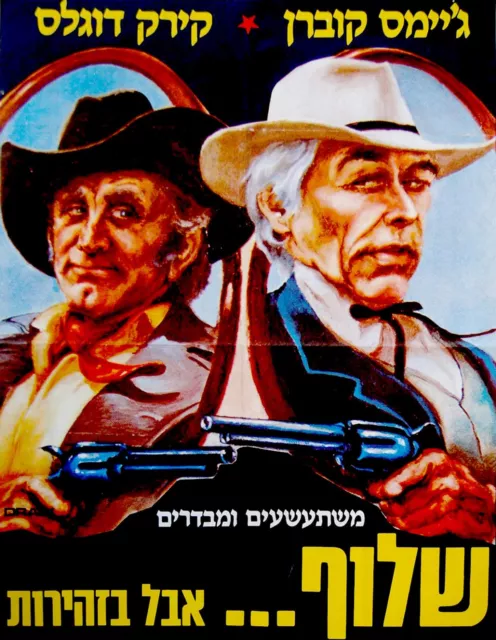
1985 Israel MOVIE POSTER Hebrew WESTERN FILM Jewish KIRK DOUGLAS JAMES COBURN
$139.23 Buy It Now 3d 23h
1974 Israel DISNEY Movie FILM POSTER Hebrew HERBIE RIDES AGAIN Jewish BEETLE
$191.38 Buy It Now 14d 11h
1985 Film HEBREW MOVIE POSTER Israel PALE RIDER Western CLINT EASTWOOD Jewish
$117.33 Buy It Now 14d 0h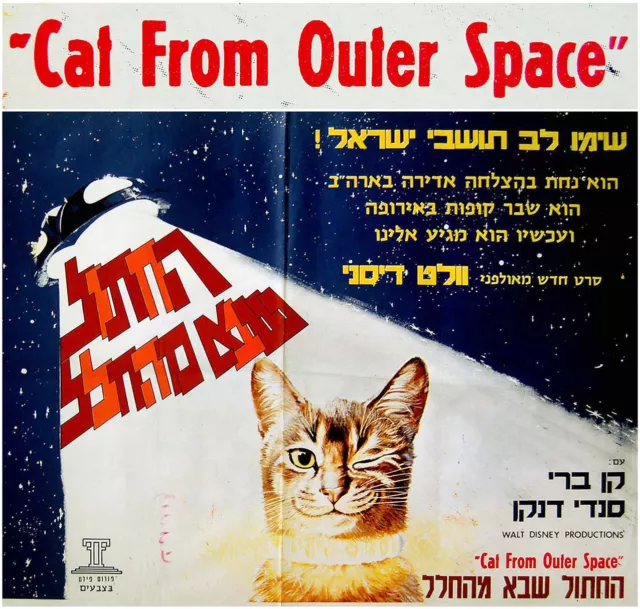
ISRAEL Hebrew RARE FILM POSTER Movie SCIENCE FICTION Disney CAT FROM OUTER SPACE
$148.61 Buy It Now 7d 23h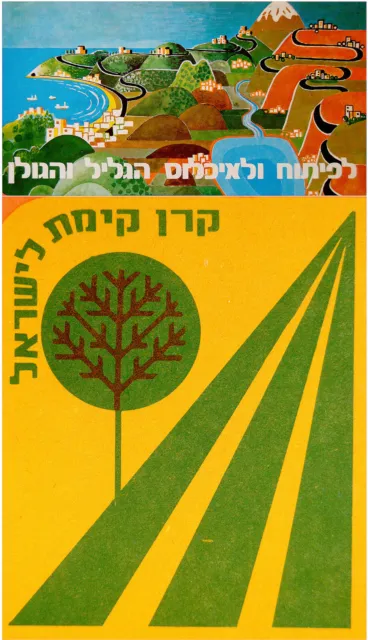
1974 Jewish ZIONIST POSTER Israel GALILEE - GOLAN HEIGHTS Hebrew KKL JNF Judaica
$70.39 Buy It Now 3d 18h
1974 Israel MOVIE POSTER Film FRONT PAGE Wilder LEMMON Matthau SARANDON Hebrew
$108.17 Buy It Now 11d 14h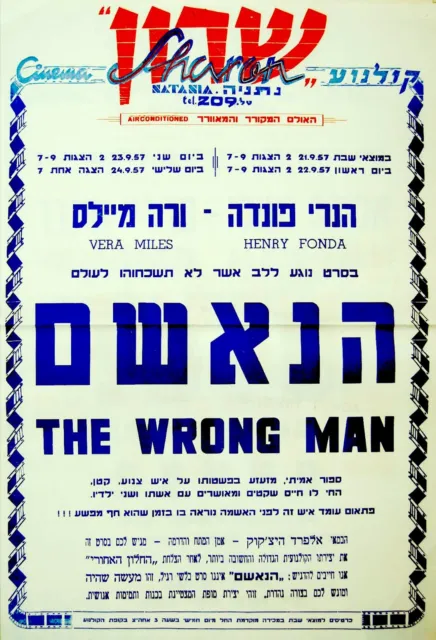
1957 Israel HITCHCOCK Movie POSTER Film THE WRONG MAN Hebrew FONDA Jewish RARE
$148.10 Buy It Now 1d 18h
1974 Vintage HEBREW Israel MOVIE POSTER Film KAZABLAN Judaica JEWISH Golan GAON
$241.30 Buy It Now 5d 14h
1968 Film HEBREW MOVIE POSTER Israel FOR FEW DOLLARS MORE Western CLINT EASTWOOD
$124.81 Buy It Now 1d 18h
1975 Israel DISNEY Movie FILM POSTER Hebrew TRUE LIFE ADVENTURES Jewish JUDAICA
$141.45 Buy It Now 24d 0h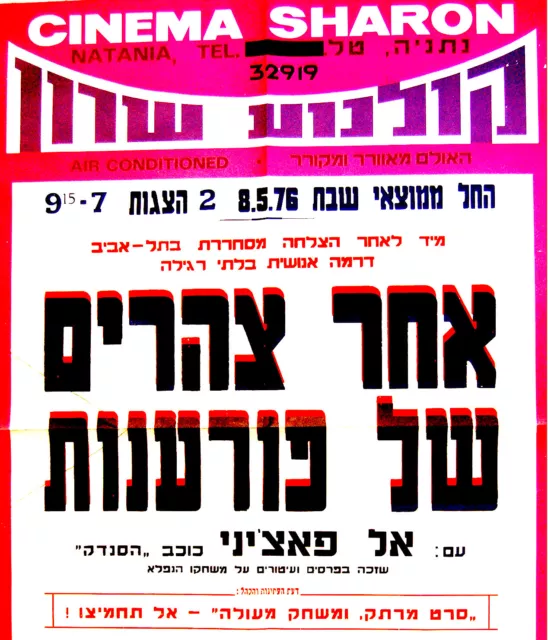
Israel MOVIE POSTER Film DOG DAY AFTERNOON Hebrew AL PACINO Sidney LUMET Jewish
$158.09 Buy It Now 10d 15h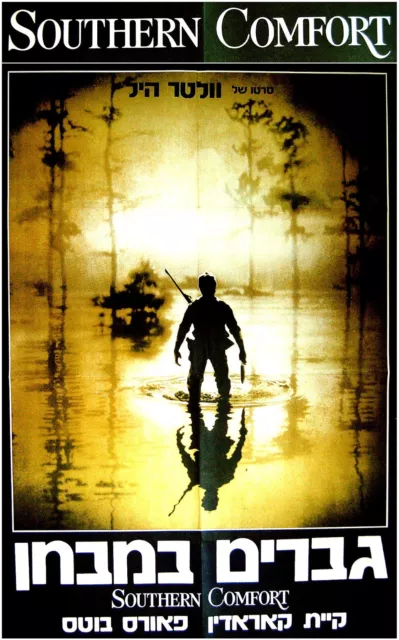
1981 Israel RARE MOVIE POSTER Film SOUTHERN COMFORT Hebrew WALTER HILL CARRADINE
$148.61 Buy It Now 17d 11h
1976 Film MOVIE POSTER Israel HIT SQUAD Hebrew SQUADRA ANTIFURTO Tomas MILIAN
$117.33 Buy It Now 10d 17h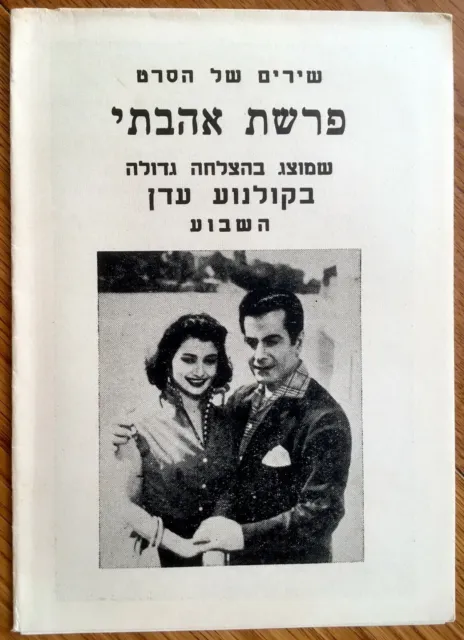
1950 Israel EGYPT Hebrew FILM MOVIE Photo BROCHURE Arabic FARID AL-ATRASH Song
$117.33 Buy It Now 21d 16h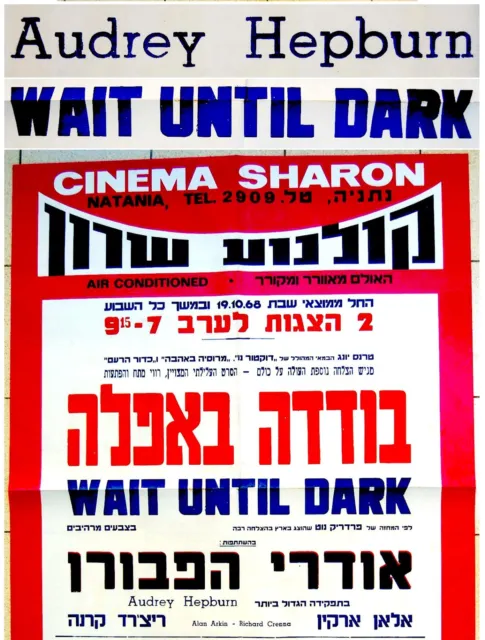
1968 Israel MOVIE POSTER Film WAIT UNTIL DARK Hebrew AUDREY HEPBURN Alan ARKIN
$158.09 Buy It Now 12d 10h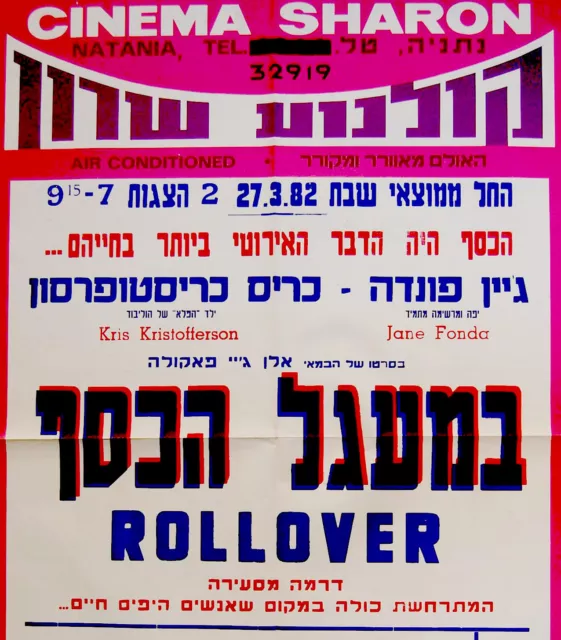
1982 Israel ROLLOVER Movie FILM POSTER Hebrew KRISTOFFERSON JANE FONDA PAKULA
$148.10 Buy It Now 10d 15h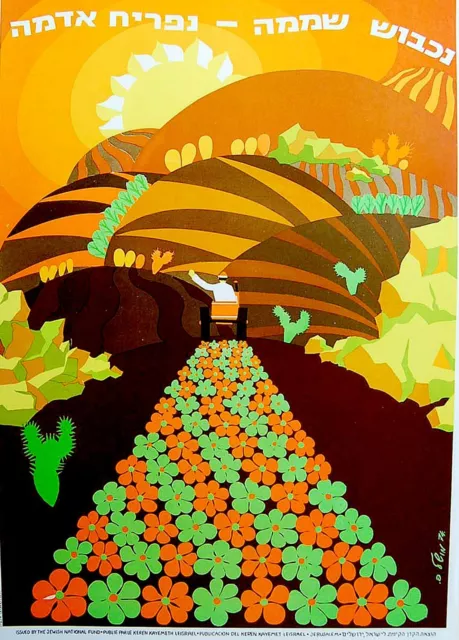
1970 Israel JEWISH ART POSTER Judaica HEBREW Gelilee JNF KKL Zionist LITHOGRAPH
$117.33 Buy It Now 2d 22h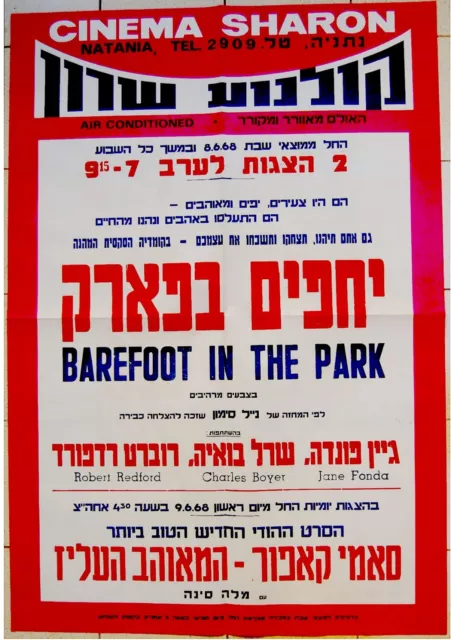
1968 Israel MOVIE POSTER Film BAREFOOT IN THE PARK Hebrew REDFORD FONDA Jewish
$148.10 Buy It Now 13h 24m
1956 Israel MOVIE FILM POSTER Hebrew VERA CRUZ Cooper LANCASTER Sarita MONTIEL
$148.10 Buy It Now 17d 17h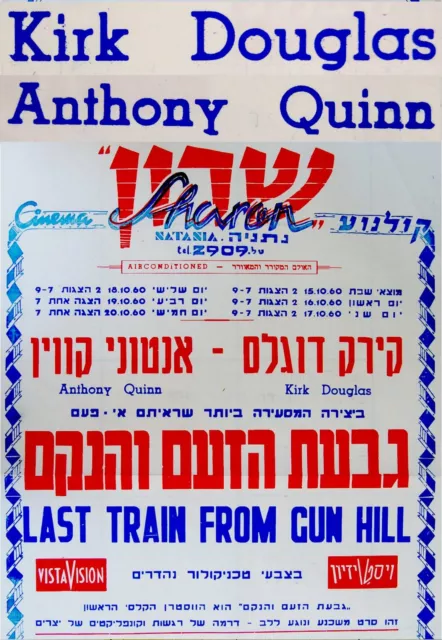
1960 Movie RARE FILM POSTER Israel LAST TRAIN FROM GUN HILL Hebrew QUINN DOUGLAS
$139.23 Buy It Now 19d 17h
1973 Israel CULT FILM Rare POSTER Bourekas URI ZOHAR Movie JEWISH Hebrew JUDAICA
$191.38 Buy It Now 10d 11h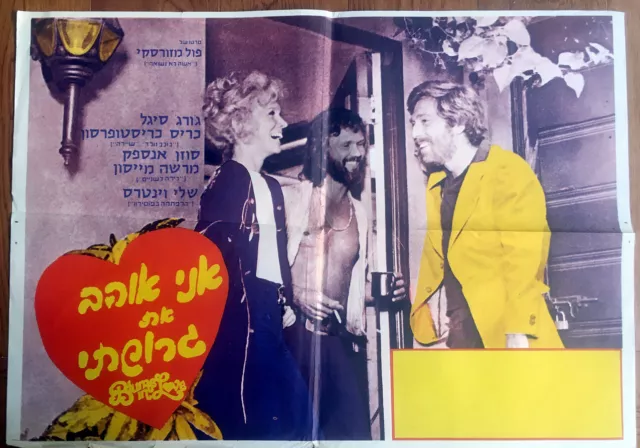
1973 Hebrew BLUME IN LOVE Israel FILM POSTER Movie KRISTOFFERSON Mazursky SEGAL
$174.74 Buy It Now 13h 18m
1950 Israel CINEMA SIGN Film MOVIE Hebrew THEATRE LOBBY POSTER Judaica HEBREW
$81.54 Buy It Now 19d 23h
1976 Original BARRY LYNDON Premiere HEBREW MOVIE Rare POSTER Israel KUBRICK FILM
$191.38 Buy It Now 16d 12h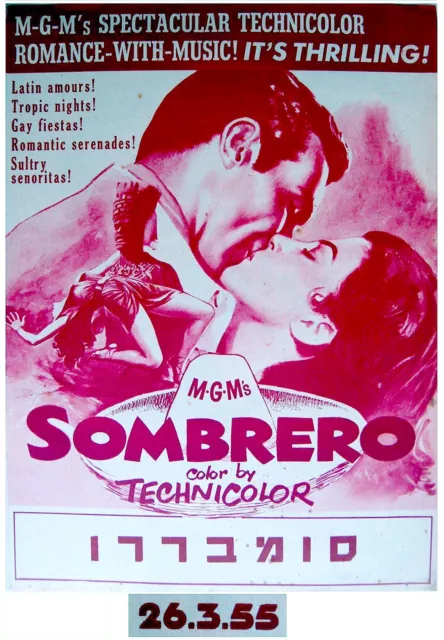
1955 Israel MOVIE Flyer RARE FILM Poster SOMBRERO Jewish CHARISSE Gassman HEBREW
$74.89 Buy It Now 30d 14h
1970 Film RARE MOVIE POSTER Israel THEY CALL ME TRINITY Hebrew WESTERN Judaica
$124.81 Buy It Now 14d 20h
1983 Israel ORIGINAL FILM POSTER Movie JOHN CASSAVETES Hebrew MAVIN And TIGE
$148.10 Buy It Now 11d 14h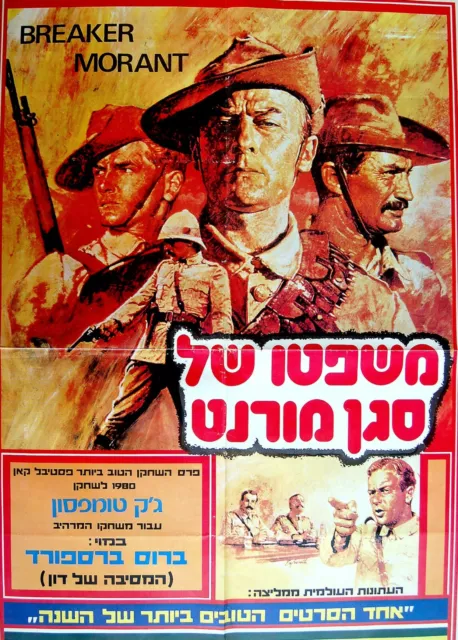 3 watchers
3 watchers1980 Israel FILM POSTER Movie BREAKER MORANT Hebrew PREMIERE Jewish JUDAICA Rare
$191.38 Buy It Now or Best Offer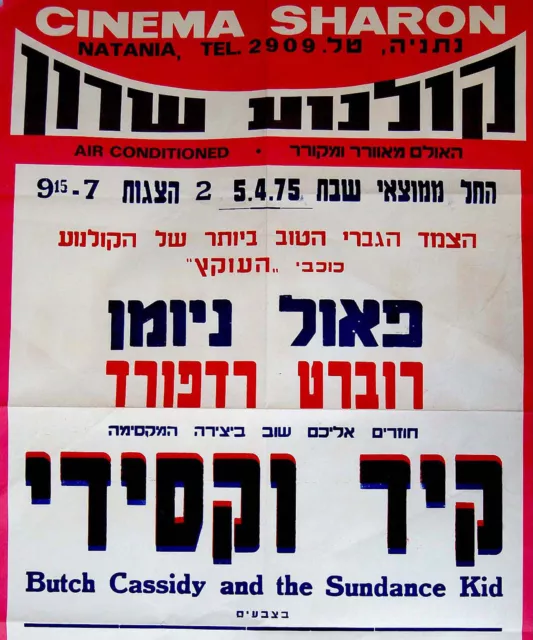
Israel MOVIE FILM POSTER Hebrew NEWMAN & REDFORD - BUTCH CASSIDY & SUNDANCE KID
$158.09 Buy It Now or Best Offer
V7668 Roman J. Israel Esq Denzel Washington Cool Movie Film WALL POSTER PRINT AU
$20.85 Buy It Now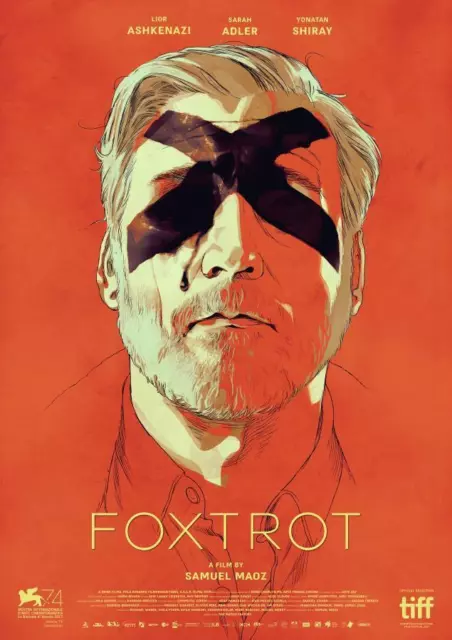
380078 Israel film Samuel Maoz Foxtrot Movie WALL PRINT POSTER AU
$29.65 Buy It Now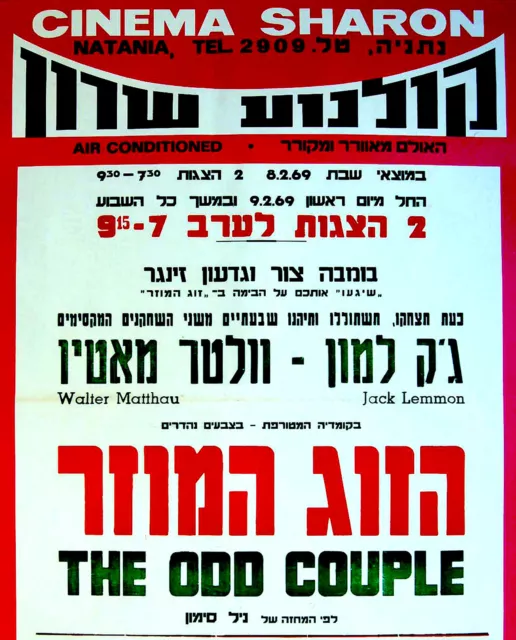
1969 Israel FILM POSTER Movie THE ODD COUPLE Lemmon MATTHAU Simon NAZRANA Hebrew
$153.93 Buy It Now or Best Offer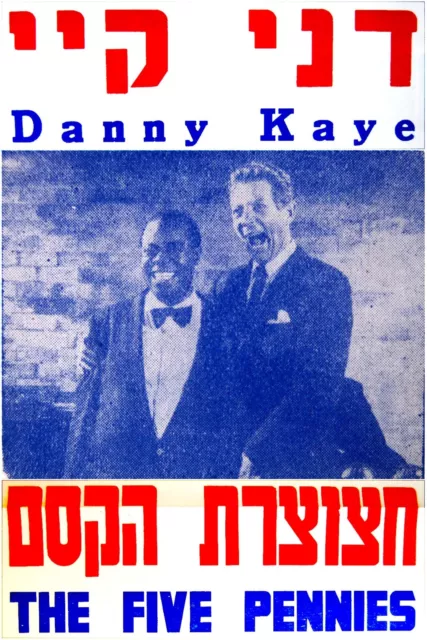
1960 Israel FIVE PENNIES Movie POSTER Film DANNY KAYE Hebrew LOUIS ARMSTRONG
$158.09 Buy It Now or Best Offer
1963 Israel KNOCK ON WOOD Movie FILM POSTER Hebrew DANNY KAYE Jewish JUDAICA
$158.09 Buy It Now or Best Offer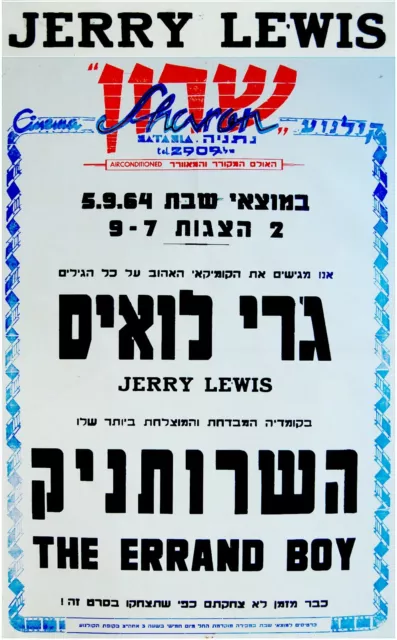
1964 Israel JERRY LEWIS Movie FILM POSTER The ERRAND BOY Jewish HEBREW Cinema
$158.09 Buy It Now or Best Offer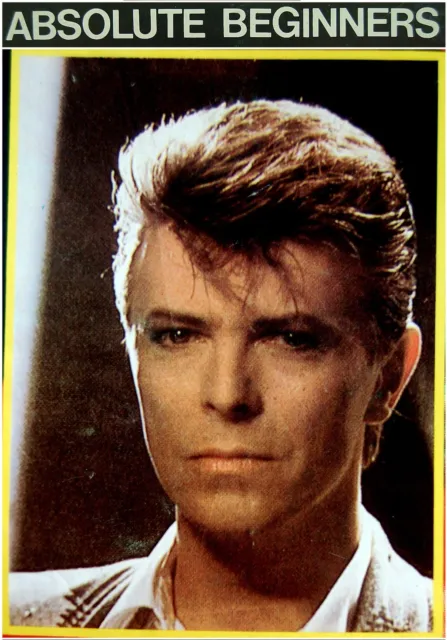
Hebrew DAVID BOWIE Israel RARE FILM POSTER Movie ABSOLUTE BEGINNERS Rock MUSICAL
$179.73 Buy It Now or Best Offer
1959 RIO BRAVO Israel MOVIE FILM POSTER Hebrew JOHN WAYNE Ricky NELSON Jewish
$124.81 Buy It Now or Best Offer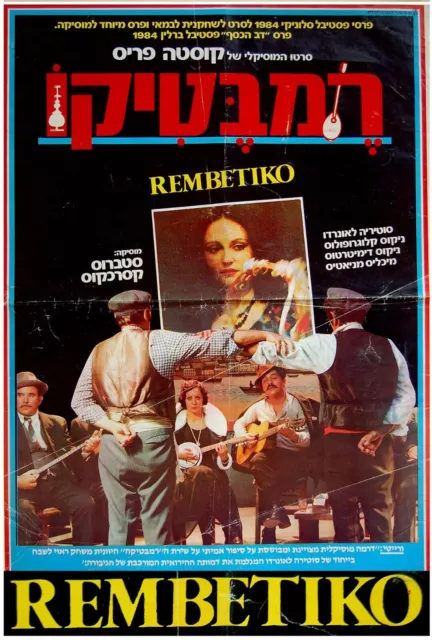
1983 Israel ORIGINAL FILM POSTER Movie REMBETICO Hebrew GREEK Music SONGS Greece
$191.38$179.89 Buy It Now or Best Offer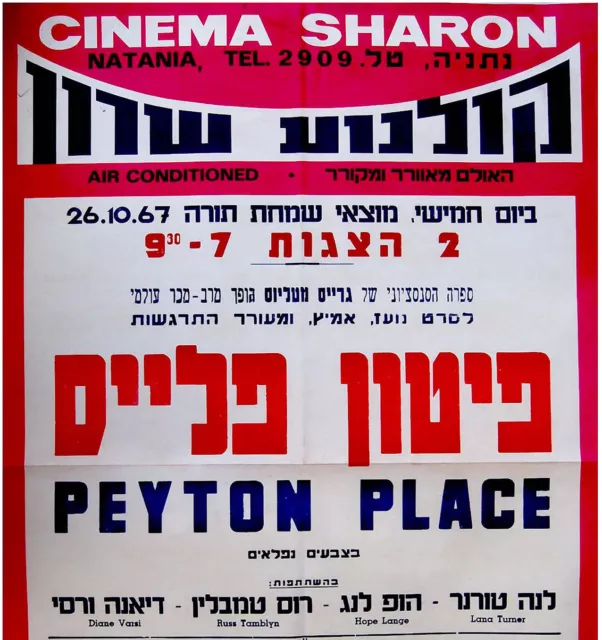
ISRAEL 1967 Hebrew PEYTON PLACE Movie FILM Original POSTER Lana TURNER Judaica
$148.11$139.22 Buy It Now or Best Offer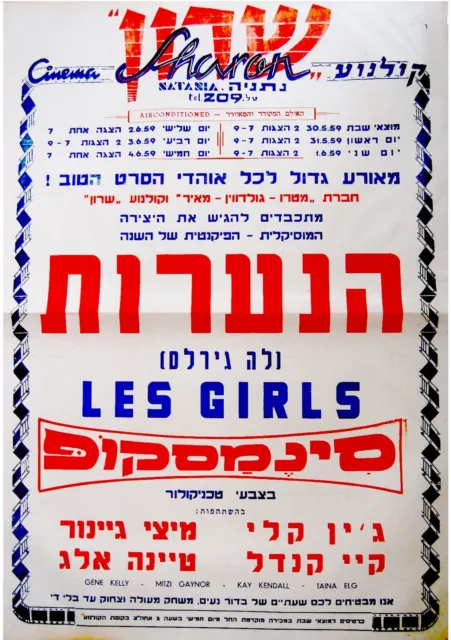 2 watchers
2 watchers1959 Israel FILM POSTER Movie LES GIRLS Hebrew COLE PORTER Gene KELLY G.CUKOR
$148.11 Buy It Now or Best Offer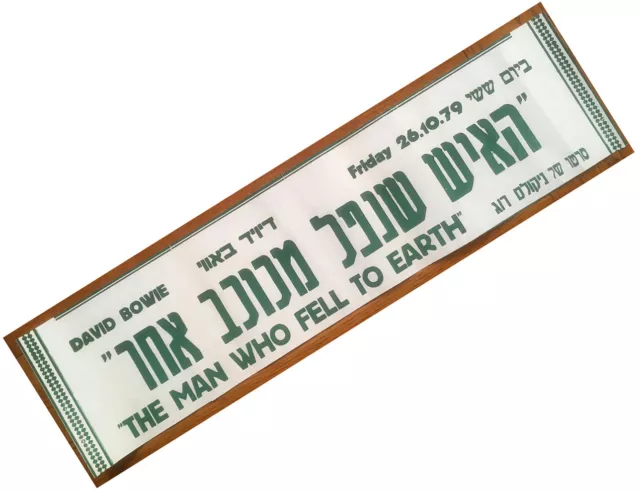 1 watcher
1 watcher1979 Hebrew DAVID BOWIE Israel RARE FILM POSTER Movie THE MAN WHO FELL To EARTH
$108.17 Buy It Now or Best Offer
BRIGITTE BARDOT Israel FILM POSTER Movie SPAGHETTI WESTERN Claudia CARDINALE
$148.11$139.22 Buy It Now or Best Offer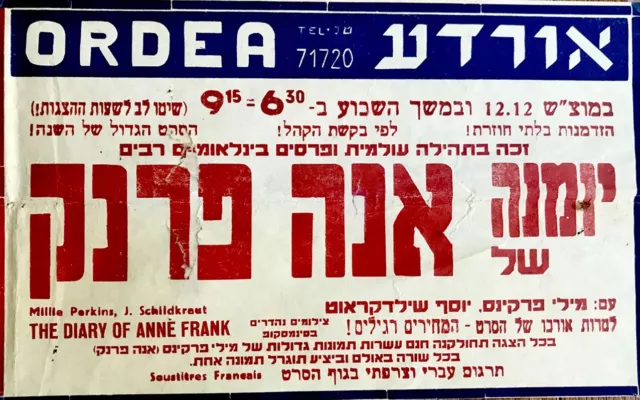
1959 Original ISRAEL Vintage MOVIE Rare FILM POSTER Hebrew ANNE FRANK Holocaust
$141.45 Buy It Now or Best Offer
1972 Israel RARE BOUREKAS FILM POSTER Hebrew CULT MOVIE COMEDY Jewish JUDAICA
$208.02 Buy It Now or Best Offer
1975 FUNNY LADY Orginal HEBREW Israel FILM POSTER Movie MUSICAL Streisand JEWISH
$114.83 Buy It Now or Best Offer
